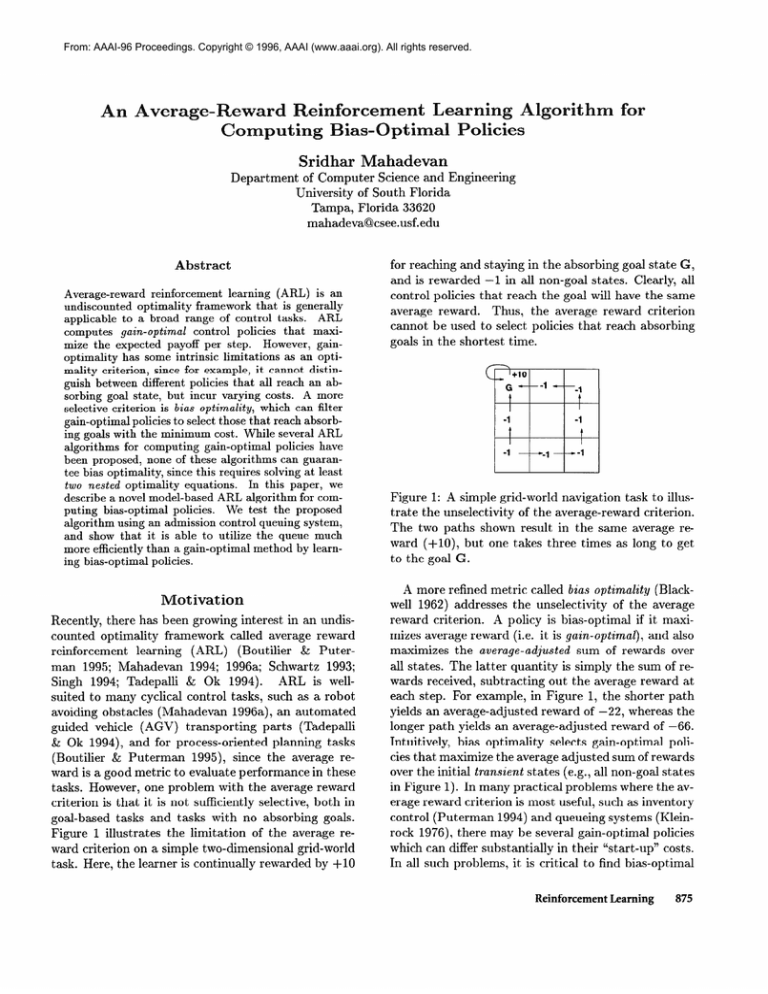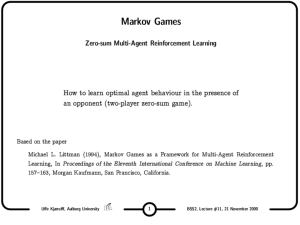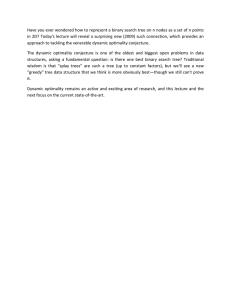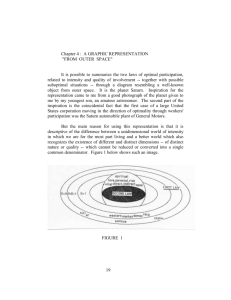
From: AAAI-96 Proceedings. Copyright © 1996, AAAI (www.aaai.org). All rights reserved.
ent Learning
n Average-
Algorit
Sridhar Mahadevan
Department
of Computer Science and Engineering
University of South Florida
Tampa, Florida 33620
mahadeva@csee.usf.edu
Abstract
Average-reward reinforcement learning (ARL) is an
undiscounted optimality framework that is generally
applicable to a broad range of control tasks. ARL
control policies that maxicomputes gain-optimal
mize the expected payoff per step.
However, gainoptimality has some intrinsic limitations as an optimality criterion, since for example, it cannot distinguish between different policies that all reach an absorbing goal state, but incur varying costs. A more
which can filter
selective criterion is bias optima&y,
gain-optimal policies to select those that reach absorbing goals with the minimum cost. While several ARL
algorithms for computing gain-optimal policies have
been proposed, none of these algorithms can guarantee bias optimality, since this requires solving at least
two nested optimality equations.
In this paper, we
describe a novel model-based ARL algorithm for computing bias-optimal policies.
We test the proposed
algorithm using an admission control queuing system,
and show that it is able to utilize the queue much
more efficiently than a gain-optimal method by learning bias-optimal policies.
Mot ivat ion
Recently, there has been growing interest in an undiscounted optimality framework called average reward
reinforcement learning (ARL)
(Boutilier
& Puterman 1995; Mahadevan 1994; 1996a; Schwartz 1993;
Singh 1994; Tadepalli & Ok 1994).
ARL is wellsuited to many cyclical control tasks, such as a robot
avoiding obstacles (Mahadevan 1996a), an automated
guided vehicle (AGV)
transporting parts (Tadepalli
& Ok 1994), and for process-oriented planning tasks
(Boutilier & Puterman 1995), since the average reward is a good metric to evaluate performance in these
tasks. However, one problem with the average reward
criterion is that it is not sufficiently selective, both in
goal-based tasks and tasks with no absorbing goals.
Figure 1 illustrates the limitation of the average reward criterion on a simple two-dimensional grid-world
task. Here, the learner is continually rewarded by +lO
for reaching and staying in the absorbing goal state 6,
and is rewarded -1 in all non-goal states. Clearly, all
control policies that reach the goal will have the same
average reward. Thus, the average reward criterion
cannot be used to select policies that reach absorbing
goals in the shortest time.
Figure 1: A simple grid-world navigation task to illustrate the unselectivity of the average-reward criterion.
The two paths shown result in the same average reward (+lO), but one takes three times as long to get
to the goal G.
A more refined metric called bias optima&y (Blackwell 1962) addresses the unselectivity of the average
reward criterion. A policy is bias-optimal if it maximizes average reward (i.e. it is gain-optimaZ), and also
maximizes the average-adjusted
sum of rewards over
all states. The latter quantity is simply the sum of rewards received, subtracting out the average reward at
each step. For example, in Figure 1, the shorter path
yields an average-adjusted reward of -22, whereas the
longer path yields an average-adjusted reward of -66.
Intuitively, bias optimality selects gain-optimal policies that maximize the average adjusted sum of rewards
over the initial transient states (e.g., all non-goal states
in Figure 1). In many practical problems where the average reward criterion is most useful, such as inventory
control (Puterman 1994) and queueing systems (Kleinrock 1976), there may be several gain-optimal policies
which can differ substantially in their “start-up” costs.
In all such problems, it is critical to find bias-optimal
ReinforcementLearning
875
policies.
While several ARL algorithms have been previously
proposed (Schwartz 1993; Singh 1994; Tadepalli & Ok
1994)) none of these algorithms will yield bias-optimal
policies in general. In particular, while they can compute the bias-optimal policy for the simple grid-world
task in Figure 1, they cannot discriminate the biasoptimal policy from the gain-optimal policy for the
simple S-state Markov decision process (MDP) given
in Figure 2, or for the admission control queueing task
shown in Figure 5. The main reason is these algorithms
only solve one optimality equation, namely the average
reward Bellman equation. It can be shown (Puterman
state is called transient, since at some finite point in
time the state will never be visited again. A recurrent
class of states is a set of recurrent states that all communicate with each other, and do not communicate
with any state outside this class. An MDP is termed
unichain if the transition matrix corresponding to every policy contains a single recurrent class, and a (possibly empty) set of transient states. Many interesting
problems involve unichain MDP’s, such as stochastic
grid-world problems (Mahadevan 1996a), the admission control queueing system shown in Figure 5, and
an AGV transporting parts (Tadepalli & Ok 1994).
1994) that solving the Bellman equation alone is insufficient to determine bias-optimal policies, whenever
there are several gain-optimal policies with different
sets of recurrent states. The MDP’s
and Figure 5 fall into this category.
given in Figure 2
In this paper we propose a novel model-based ARL
algorithm that is explicitly designed to compute biasoptimal policies. This algorithm is related to previous ARL algorithms but significantly extends them
by solving two nested optimality equations to determine bias-optimal policies, instead of a single equation.
We present experimental results using an admission
control queuing system, showing that the new biasoptimal algorithm is able to learn to utilize the queue
much more efficiently than a gain-optimal algorithm
that only solves the Bellman equation.
Gain and Bias Optimality
We assune the standard Markov decision process
(MDP) framework (Puterman 1994). An MDP consists of a (finite or infinite) set of states S, and a (finite
or infinite) set of actions A for moving between states.
In this paper we will assume that S and A are finite.
We will denote the set of possible actions in a state
x by A(x).
Associated with each action a is a state
transition matrix P(u), where pZy(u) represents the
probability of moving from state x to y under action a.
There is also a reward or payoff function T : S x A + 72,
where r(x, a) is the expected reward for doing action a
in state 2.
A stationary deterministic
policy is a mapping x :
S + A from states to actions. In this paper we consider only such policies, since a stationary deterministic bias-optimal policy exists. Two states x and y communicate under a policy x if there is a positive probability of reaching (through zero or more transitions)
each state from the other. A state is recurrent under
a policy x if starting from the state, the probability of
eventually reentering it is 1. Note that this implies that
recurrent states will be visited forever. A non-recurrent
876
Learning
+o
\h
a2
al
Figure 2: A simple 3-state MDP that illustrates the
unselectivity of the average reward criterion in MDP’s
with no absorbing goal states. Both policies in this
MDP are gain-optimal, however only the policy that
selects action al in state A is bias-optimal.
Average reward MDP aims to compute policies that
yield the highest expected payoff per step. The average
reward p”(x) associated with a particular policy r at
a state x is defined as
p”(x)= Jiil
E (CL1 Jw4)
N
,
QXE s,
where RF(x) is the reward received at time t starting
from state x, and actions are chosen using policy 7r.
E( .) denotes the expected value. A gain-optimal policy
X* is one that maximizes the average reward over all
states, that is, p”*(x) 2 p”(x) over all policies 7r and
states 2. Note that in unichain MDP’s, the average
reward of any policy is state independent.
That is,
p”(x) = p”(y) = p”,
vx,y E s,v7r.
As shown in Figure 1, gain-optimality
is not sufficiently selective in goal-based tasks, as well as in tasks
with no absorbing goals. A more selective criterion
called bias optimality addresses this problem. The average adjusted sum of rewards earned following a policy
7r (assuming an aperiodic MDP) is
N-l
VT(s)
= jiliWE
x
vm)
t=o
- P”>
7
where p” is the average reward associated with policy
K. .4 policy X* is termed bias-optimal if it is gainoptimal, and it also maximizes the average-adjusted
values, that is VT* (2) 2 Vr( x) over all x E S and
policies X. The relation between gain-optimal and biasoptimal policies is depicted in Figure 3.
Theorem
2 Let V be a value function
and p be a
scalar that together satisfy Equation 1. Define Av(i) C
A(i) to be the set of actions that maximize the rightThere exists a function
hand side of Equation
I.
W : S + R satisfying
the equation
over all states
such that any policy formed by choosing actions in Av
that maximize the right-hand side of the above equation
is bias-optimal.
Figure 3: This diagram illustrates the relation between
gain-optimal and bias-optimal policies.
In the example 3-state MDP in Figure 2, both policies are gain-optimal since they yield an average reward of 1. However, the policy r that selects action
al in state A generates bias values V”(A)
= 0.5,
V”(B)
= -0.5, and V”-(C) = 1.5. The policy x is
bias-optimal because the only other policy is 7r’that
selects action a2 in state A, and generates bias values
VT’(A) = -0.5, VT’(B) = -1.5, and Y’(C)
= 0.5.
Bias-Optimality
Equations
The key difference between gain and bias optimality
is that the latter requires solving two nested optimality equations for a unichain MDP. The first equation
is the well-known average-reward analog of Bellman’s
optimality equation.
Theorem 1 For any MDP that is either unichain or
communicating,
there exists a value function V* and a
scalar p* satisfying the equation over all states
such that the greedy policy rr* resulting from V*
achieves the optimal average reward p* = pX* where
P=* 2 pr over all policies n.
Here, “greedy” policy means selecting actions that
maximize the right hand side of the above Bellman
equation. There are many algorithms for solving this
equation, ranging from DP methods (Puterman 1994)
to ARL methods (Schwartz 1993). However, solving
this equation does not suffice to discriminate between
bias-optimal and gain-optimal policies for a unichain
MDP. In particular, none of the previous ARL algorithms can discriminate between the bias-optimal policy and the gain-optimal policy for the 3-state MDP
in Figure 2. A second optimality equation has to be
solved to determine the bias-optimal policy.
These optimality equations are nested, since the set
Av of actions over which the maximization is sought
in Equation 2 is restricted to those that maximize the
right-hand side of Equation 1. The function W, which
we will refer to as the bias oflset, holds the key to policy
improvement, since it indicates how close a policy is to
achieving bias-optimality.
ias-Opt imality
A Model-based
Algorithm
We now describe a model-based algorithm for computing bias-optimal policies for a unichain MDP. The
algorithm estimates the transition probabilities from
online experience, similar to (Jalali & Ferguson 1989;
Tadepalli & Ok 1994). However, unlike these previous
algorithms, the proposed algorithm solves both optimality equations (Equation 1 and Equation 2 above).
Since the two equations are nested, one possibility is
to solve the first equation by successive approximation,
and then solve the second equation. However, stopping the successive approximation process for solving
the first equation at any point will result in some finite
error, which could prevent the second equation from
being solved. A better approach is to interleave the
successive approximation process and solve both equat ions simultaneously (Federgruen
The bias optimality algorithm
& Schweitzer 1984).
is described in Fig-
ure 4. The transition probabilities P;j(u) and expected
rewards r(i, a) are inferred online from actual transitions (steps 7 through 10). The set h(i) represents all
actions in state i that maximize the right-hand side of
Equation 1 (step 3). The set w(i), on the other hand,
refers to the subset of actions in h(i) that also maximize the right-hand side of Equation 2. The algorithm
successively computes A(i,e,)
and w(i,cn),
the set of
gain-optimal actions that are within E, of the maximum value, and the set of bias-optimal actions within
this gain-optimal set. This allows the two nested equations to be solved simultaneously. Here, E, is any series
of real numbers that slowly decays as n + 00, similar
to a “learning rate”. Note that since the algorithm is
ReinforcementLearning
877
based on stochastic approximation, some residual error
is unavoidable, and thus e‘n should be decayed only up
to some small value > 0.
The algorithm normalizes the bias values and bias
offset values by grounding these quantities to 0 at a
reference state. This normalization bounds these two
quantities, and also improves the numerical stability
of average reward algorithms (Puterman 1994). In the
description, we have proposed choosing the reference
state that is recurrent under all policies, if such exists,
and is known beforehand. For example, in a standard
stochastic grid-world problem (Mahadevan 1996a), the
goal state satisfies this condition.
In the admission
control queueing task in Figure 5, the state (0,O) satisfies this condition.
The policy output by the algorithm maximizes the expected bias offset value, which,
as we discussed above, is instrumental in policy improvement .
Bias Optimality in an Admission
Control Queuing System
We now present some experimental results of the proposed bias optimality algorithm using an admission
control system, which is a well-studied problem in
queueing systems (Kleinrock 1976). Generally speaking, there are a number of servers, each of which provides service to jobs that are arriving continuously according to some distribution. In this paper, for the sake
of simplicity, we assume the M/M/l queuing model,
where the arrivals and service times are independent,
memoryless, and distributed exponentially, and there
is only 1 server. The arrival rate is modeled by parameter X, and the service rate by parameter ,Y. At each
arrival, the queue controller has to decide whether to
admit the new job into the queue, or to reject it. If admitted, each job immediately generates a fixed reward
R for the controller, which also incurs a holding cost
f(j) for the j jobs currently being serviced.
The aim is to infer an optimal policy that will maximize the rewards generated by admitting new jobs, and
simultaneously minimize the holding costs of the existing jobs in the queue. Stidham(Stidham
1978) proved
that if the holding cost function f(j) is convex and nondecreasing, a control limit policy is optimal. A control
limit policy is one where an arriving new job is admitted into the queue if and only if there are fewer than
L jobs in the system. Recently, Haviv and Puterman
(Haviv & Puterman ) show that if the cost function
f(j) = cj, there are at most two gain-optimal control
limit policies, namely admit Z and admit L + 1, but
only one of them is also bias-optimal (admit L+ 1). Intuitively, the admit L+ 1 policy is bias-optimal because
the additional cost of the new job is offset by the extra
878
Learning
1. Initialization: Let n = 0, bias function V(x) = 0,
and bias-offset function W(x) = 0. Let the initial
state be i. Initialize N(i, a) = 0, the number of times
action a has been tried in state i. Let T(i, a, k) = 0,
the number of times action a has caused a transition
from i to k. Let the expected rewards r(i,u)
= 0.
Let s be some reference state, which is recurrent
under all policies.
2. Let H(i,u)
= r(i,u)
+ Cj
P;j(u)V(j),
Vu E A(i).
Let
3. Let h(i) = {a E A(i)ju maximizes H(i,u)}.
A(i,E,)
be the set of actions that are within en of
the maximum H(i, a) value.
4. Let
cj
w(i, e,)
=
{a
E
A(i,E,)lu
maximizes
P;jwwJJ~.
5. With probability 1 --pezp, select action A to be some
a, E w(i, en). Otherwise let action A be any random
action a, E A(i).
6. Carry out action A. Let the next state be k, and
immediate reward be +(i, a).
7. N(i, A) t
N(i, A) + 1.
8. T(i, A, k) t
9. P&A)
10. &A)
11.
v@>
12.
w@>
T(i, A, k) + 1.
t
w.
+
r(4 -A)(1 - &--&
+
fnaXaEA(i)(H(i7
+
maXuEA(s,Q
maXaEA(i,c,)
(Cj
%WW~)
13. If n < MAXSTEPS,
and go to step 5.
a>> -
(xi
+ &+,a).
maXaEA(s)
Pij(a)W(j)
-
set n t
(H(%
-
a>>.
v(i))
-
VW).
n + 1, and i t
k
14. Output n(i) E w(i,e,).
Figure 4: A model-based algorithm for computing biasoptimal policies for unichain MDP’s.
reward received. Note that
return, a policy that results
better than one that results
provided the average reward
since rejected jobs never
in a larger queue length is
in a smaller queue length,
of both policies are equal.
Since the M/n/r/l queuing
model
is a continuous
time MDP, we first convert it by uniformization
(Puterman 1994) into a discrete time MDP. Figure 5 illustrates the general structure of the uniformized M/M/l
admission control queuing system. States in the figure
are pairs (s, j), where s represents the number of jobs
currently in the queue, and j is a boolean-valued variable indicating whether a new job has arrived. In states
(s, l), there are two possible actions, namely reject the
new job (a = 0), or admit the new job (a = 1). In
states (s,O), there is only one possible action, namely
continue the process (a = 0). Theoretically, there is an
infinite number of states in the system, but in practice,
a finite upper bound needs to be imposed on the queue
size. Note that the two gain-optimal policies (admit L
and admit L+ 1) have different sets of recurrent states,
just as the 3-state MDP in Figure 2. States (0,~) to
(L - 1, x) form a recurrent class in the admit L policy,
whereas states (0, x) to (L, x) form the recurrent class
in the admit L + 1 policy.
the uniformization
process.
r((O,O),O) =
r( (0, 1), 0) = 0.
r((s,l),l)
=
[R-f(s+l)](X+&
7’@, Oh 0)
=
r((s, l),O)
~29
= -f(s)@
+ /&
s r 1.
Table 1 compares the performance of the biasoptimal algorithm with a simplified gain-optimal algorithm for several sets of parameters for the admission control system. We selected these from a total
run of around 600 parameter combinations since these
produced the largest improvements. Each combination
was tested for 30 runs, with each run lasting 200,000
steps. Of these 600 parameter sets, we observed improvements of 25% or more in a little over 100 cases. In
all other cases, the two algorithms performed equivalently, since they yielded the same average reward and
average queue length. In every case shown in the table,
there is substantial improvement in the performance
of the bias-optimal algorithm, as measured by the increase in the average size of the queue. What this
means in practice is that the bias-optimal algorithm
allows much better utilization of the queue, without increasing the cost of servicing the additional items in the
queue. Note that the improvement will occur whenever
there are multiple gain-optimal policies, only one of
which is bias-optimal. If there is only one gain-optimal
policy, the bias optimality algorithm will choose that
policy and thus perform as well as the gain-optimal
algorithm.
Figure 5: This diagram illustrates the MDP representation of the uniformized M/M/l
admission control
queuing system for the average reward case.
The reward function for the average reward version
of the admission control queuing system is as follows.
If there are no jobs in the queue, and no new jobs have
arrived, the reward is 0. If a new job has arrived and
admitted in state s, the reward equals to the difference
between the fixed payoff R for admitting the job and
the cost of servicing the s + 1 resulting jobs in the
queue. Finally, if the job is not admitted, the reward
is the service cost of the existing s jobs. There is an
additional multiplicative term X + p that results from
Table
4
4
12
1
48.0%
2
2
15
1
47.9%
1:
This
table
compares
the performance
of
the model-based bias-optimal algorithm with a (gainoptimal) simplification of the same algorithm that only
solves the Bellman equation.
Related
Work
To our knowledge, the proposed bias optimality algorithm represents the first ARL method designed explicitly for bias optimality. However, several previous algoReinforcementLearning
879
rithms exist in the DP and OR literature. These range
from policy iteration (Veinott 1969; Puterman 1994)
to linear programming (Denardo 1970). Finally, Federgruen and Schweitzer (Federgruen & Schweitzer 1984)
study successive approximation methods for solving a
general sequence of nested optimality equations, such
as Equation 1 and Equation 2. We expect that biasoptimal ARL algorithms, such as the one described in
this paper, will scale better than these previous nonadaptive bias-optimal algorithms. Bias-optimal ARL
algorithms also have the added benefit of not requiring
detailed knowledge of the particular MDP. However,
these previous DP and OR algorithms are provably
convergent, whereas we do not yet have a convergence
proof for our algorithm.
Future Work
This paper represents the first step in studying bias
optimality in ARL. Among the many interesting issues
to be explored are the following:
Model-free Bias Optimality Algorithm: We have also
developed a model-free bias optimality algorithm
(Mahadevan 1996b), which extends previous modelfree ARL algorithms, such as R-learning (Schwartz
1993), to compute bias optimal policies by solving
both optimality equations.
Scale-up Test on More Realistic Problems:
In this
paper we only report experimental results on an admission control queuing domain. We propose to test
our algorithm on a wide range of other problems,
including more generalized queuing systems (Kleinrock 1976) and robotics related tasks (Mahadevan
1996a).
Acknowledgements
am indebted to Martin Puterman for many discussions regarding bias optimality.
I thank Larry Hall,
Michael Littman, and Prasad Tadepalli for their detailed comments on this paper. I also thank Ken Christensen for helping me understand queueing systems.
This research is supported in part by an NSF CAREER
Award Grant No. IRI-9501852.
References
Blackwell, D. 1962. Discrete dynamic programming.
Annals of Mathematical
Statistics 331719-726.
Boutilier, C., and Puterman, M.
1995. Processoriented planning and average-reward optimality. In
Proceedings of the Fourteenth JCAI, 1096-1103. Morgan Kaufmann.
880
Learning
Denardo, E. 1970. Computing a bias-optimal policy in
a discrete-time Markov decision problem. Operations
Research 18:272-289.
Federgruen, A., and Schweitzer, P. 1984. Successive
approximation methods for solving nested functional
equations in Markov decision problems. Mathematics
of Operations Research 9:319-344.
Haviv, M., and Puterman, M. Bias optimality in controlled queueing systems. To Appear in Journal of
Applied Probability.
Jalali, A., and Ferguson, M.
1989. Computation& efficient adaptive control algorithms for Markov
chains. In Proceedings of the 28th IEEE Conference
on Decision and Control, 1283-1288.
Kleinrock,
L. 1976. Queueing
Systems.
John Wiley.
Mahadevan, S. 1994. To discount or not to discount in reinforcement learning: A case study comparing R-learning and Q-learning. In Proceedings of
the Eleventh International
Conference
on Machine
Learning, 164-l 72. Morgan Kaufmann.
Mahadevan, S. 1996a. Average reward reinforcement
learning: Foundations, algorithms, and empirical results. Machine Learning 22: 159-196.
Mahadevan, S. 199613. Sensitive-discount optimality: Unifying average-reward and discounted reinforcement learning. In Proceedings of the 13th International Conference
on Machine Learning.
Morgan
Kaufmann. To Appear.
Puterman, M. 1994. Marhov Decision Processes: Discrete Dynamic Stochastic Programming.
John Wiley.
Schwartz, A. 1993. A reinforcement learning method
for maximizing undiscounted rewards. In Proceedings
of the Tenth International
Conference
on Machine
Learning, 298-305. Morgan Kaufmann.
Singh, S. 1994. Reinforcement learning algorithms
for average-payoff Markovian decision processes. In
Proceedings of the 12th AAAI. MIT Press.
Stidham, S. 1978. Socially and individually optimal
control of arrivals to a GI/M/l queue. Management
Science 24( 15).
Tadepalli, P., and Ok, D. 1994. H learning: A reinforcement learning method to optimize undiscounted
average reward. Technical Report 94-30-01, Oregon
State Univ.
Veinott, A. 1969. Discrete dynamic programming
with sensitive discount optimality criteria. Annals of
Mathematical
Statistics 40(5):1635-1660.





